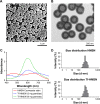Transferrin receptor-targeted HMSN for sorafenib delivery in refractory differentiated thyroid cancer therapy
- PMID: 30584304
- PMCID: PMC6289230
- DOI: 10.2147/IJN.S187240
Transferrin receptor-targeted HMSN for sorafenib delivery in refractory differentiated thyroid cancer therapy
Abstract
Background: Thyroid cancer becomes the most common endocrine cancer with the greatest growing incidence in this decade. Sorafenib is a multikinase inhibitor for the treatment of progressive radioactive iodine-refractory differentiated thyroid cancer (DTC), while the off-target toxicity effect is usually inconvenient for patients taking.
Methods: In this study, hollow mesoporous silica nanoparticles (HMSNs) with transferrin modification (Tf-HMSNs) were loaded with sorafenib (sora@Tf-HMSNs) to help targeted delivery of sorafenib. Due to the biocompatible Tf shell, Tf-HMSNs exhibited excellent bio-compatibility and increased intracellular accumulation, which improved the targeting capability to cancer cells in vitro and in vivo.
Results: Sora@Tf-HMSNs treatment exhibited the strongest inhibition effect of res-TPC-1 cells and res-BCPAP cells compared with sora@HMSNs and sorafenib groups and induced more cancer cell apoptosis. Finally, Western blot analysis was conducted to check the expression of RAF/MEK/ERK signaling pathway after sorafenib encapsulated Tf-HMSNs treatment.
Conclusion: Overall, sora@Tf-HMSNs can significantly increase the effective drug concentration in cancer cells and thus enhance the anticancer effect, which are expected to be promising nanocarriers to deliver anticancer drugs for effective and safe therapy for RAI-refractory DTC.
Keywords: RAF/MEK/ERK; RAI-refractory DTC; hollow mesoporous silica nanoparticles; sorafenib; transferrin.
Conflict of interest statement
Disclosure The authors report no conflicts of interest in this work.
Figures









Similar articles
-
Inhibition of growth of hepatocellular carcinoma by co-delivery of anti-PD-1 antibody and sorafenib using biomimetic nano-platelets.BMC Cancer. 2024 Feb 26;24(1):273. doi: 10.1186/s12885-024-12006-1. BMC Cancer. 2024. PMID: 38409035 Free PMC article.
-
Aerosol technique-based carbon-encapsulated hollow mesoporous silica nanoparticles for synergistic chemo-photothermal therapy.Acta Biomater. 2019 Apr 1;88:448-461. doi: 10.1016/j.actbio.2019.02.029. Epub 2019 Feb 26. Acta Biomater. 2019. PMID: 30818051
-
Efficacy-shaping nanomedicine by loading Calcium Peroxide into Tumor Microenvironment-responsive Nanoparticles for the Antitumor Therapy of Prostate Cancer.Theranostics. 2020 Aug 2;10(21):9808-9829. doi: 10.7150/thno.43631. eCollection 2020. Theranostics. 2020. PMID: 32863961 Free PMC article.
-
Hollow mesoporous silica nanoparticles for drug formulation and delivery: Opportunities for cancer therapy.Colloids Surf B Biointerfaces. 2025 May;249:114534. doi: 10.1016/j.colsurfb.2025.114534. Epub 2025 Jan 25. Colloids Surf B Biointerfaces. 2025. PMID: 39874869 Review.
-
Lenvatinib: Role in thyroid cancer and other solid tumors.Cancer Treat Rev. 2016 Jan;42:47-55. doi: 10.1016/j.ctrv.2015.11.003. Epub 2015 Dec 2. Cancer Treat Rev. 2016. PMID: 26678514 Review.
Cited by
-
Current Application of Nanoparticle Drug Delivery Systems to the Treatment of Anaplastic Thyroid Carcinomas.Int J Nanomedicine. 2023 Oct 25;18:6037-6058. doi: 10.2147/IJN.S429629. eCollection 2023. Int J Nanomedicine. 2023. PMID: 37904863 Free PMC article. Review.
-
Multimodal Decorations of Mesoporous Silica Nanoparticles for Improved Cancer Therapy.Pharmaceutics. 2020 Jun 8;12(6):527. doi: 10.3390/pharmaceutics12060527. Pharmaceutics. 2020. PMID: 32521802 Free PMC article. Review.
-
Recent advances in nanomedicine for the diagnosis and therapy of thyroid disorders.3 Biotech. 2025 Mar;15(3):67. doi: 10.1007/s13205-025-04234-4. Epub 2025 Feb 24. 3 Biotech. 2025. PMID: 40012722 Review.
-
Nanoparticles: Promising Auxiliary Agents for Diagnosis and Therapy of Thyroid Cancers.Cancers (Basel). 2021 Aug 12;13(16):4063. doi: 10.3390/cancers13164063. Cancers (Basel). 2021. PMID: 34439219 Free PMC article. Review.
-
Enhanced cytotoxicity of a redox-sensitive hyaluronic acid-based nanomedicine toward different oncocytes via various internalization mechanisms.Drug Deliv. 2020 Dec;27(1):128-136. doi: 10.1080/10717544.2019.1709919. Drug Deliv. 2020. PMID: 31894722 Free PMC article.
References
-
- Wartofsky L. Increasing world incidence of thyroid cancer: increased detection or higher radiation exposure? Hormones. 2010;9(2):103–108. - PubMed
-
- American Thyroid Association Guidelines Taskforce on Thyroid Nodules and Differentiated Thyroid Cancer. Cooper DS, Doherty GM, Haugen BR, et al. Revised American Thyroid Association management guidelines for patients with thyroid nodules and differentiated thyroid cancer. Thyroid. 2009;19(11):1167–1214. - PubMed
-
- Shoup M, Stojadinovic A, Nissan A, et al. Prognostic indicators of outcomes in patients with distant metastases from differentiated thyroid carcinoma. J Am Coll Surg. 2003;197(2):191–197. - PubMed
-
- Durante C, Haddy N, Baudin E, et al. Long-term outcome of 444 patients with distant metastases from papillary and follicular thyroid carcinoma: benefits and limits of radioiodine therapy. J Clin Endocrinol Metab. 2006;91(8):2892–2899. - PubMed
MeSH terms
Substances
LinkOut - more resources
Full Text Sources
Medical
Research Materials
Miscellaneous

